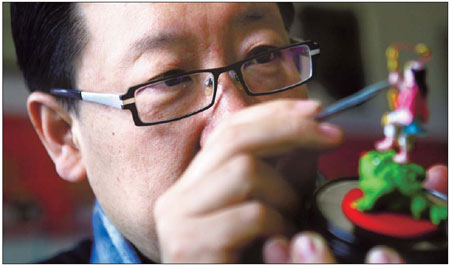Culture
Kneading innovation
By Wu Wencong (China Daily)
Updated: 2011-03-23 07:41
 |
Large Medium Small |
|
Peng Xiaoping's sculpting education comes mostly through self-study and practice. He believes folk arts are easy to learn and hard to master. [Photo/China Daily] |
|
Some of Peng's representative pieces. Above: Legend of the White Snake. Middle: A traditional Chinese bride and groom. Below: A drowsy cherub. |

An acclaimed dough figurine sculptor has crafted a career outside of conventions and carved out a market for miniatures that bear an innovative flair. Wu Wencong reports.
The baby doll with rosy cheeks, half-closed eyes and delicate white wings in this studio in Beijing is incredible - not only in its lifelikeness but also in that it is fewer than 2 cm high and sculpted from dough.
The drowsy cherub is part of Peng Xiaoping's vast collection of miniatures, many of which are barely larger than a fingernail.
"That's my favorite piece," the 50-year-old craftsman said, as he pointed to a photograph hanging on a wall of a walnut shell containing 22 tiny dolls.
"I call it 'Ant Sculpture'. It shows a gathering of 22 fairies from a traditional folk tale," he said.
"I refuse to sell it, even though someone once offered me 100,000 yuan."
Peng is a maverick among skilled Chinese handicraftsmen in the way he entered his trade. Unlike the vast majority of his contemporaries, he has never been the apprentice of a famous master. Since he started playing with plasticine as a 3-year-old, much of his dough sculpting education has come through self-study and working under less acclaimed practitioners.
This, he said, has allowed him to blaze his own trail.
"I've been acknowledged for my work by my peers and in the market - not just for working under a great master," he told METRO.
A Japanese collector in his 70s has been buying Peng's dough models for 17 years. About 70 percent of the dough sculptures sold in the market are made by Peng and his apprentices. He has taught thousands of people over the past 30 years - the eldest being age 42 - although not many have ended up making a living from the craft.
His artistic signatures are the teeny "ant sculpture" style and monochromatic miniatures.
One of his representative works is a realistic sculpture of ginseng. The way the branches are of different sizes and project from the root in different directions, as well as the pocked effect used on the main branch, make it look as if the root was freshly excavated from the soil.
Another masterpiece features the Goddess of Mercy sitting cross-legged under a tree. The dough's milky white color makes it resemble ivory.
While most dough sculptors focus on such subject matters as figures from Chinese history, Peng also takes inspiration from the West. Some such works include the Statue of Liberty and Shakespearean characters.
Peng explained that sculptors add nine materials to the dough. While every master has his own recipe, they are all concocted to make the material resistant to worms, splitting and rotting.
Basically, the craftsman's secret weapon is a plastic stick that is broad and flat on one end, and thin and sharp on the other. While it may seem rudimentary, Peng explained the tool is the result of years of cultivation.
It is essentially by using different parts of the stick to press, poke and carve the dough that the figurines are endowed with their lifelikeness.
Peng said he could teach anyone how to fashion a small animal within two hours. But a traditional maiden requires at least seven days of study.
"One of the qualities of Chinese folk arts that makes them appealing to ordinary people is that they are easy to learn and difficult to master," he said.
Related story: Dough Figurine Lang
| 分享按钮 |

